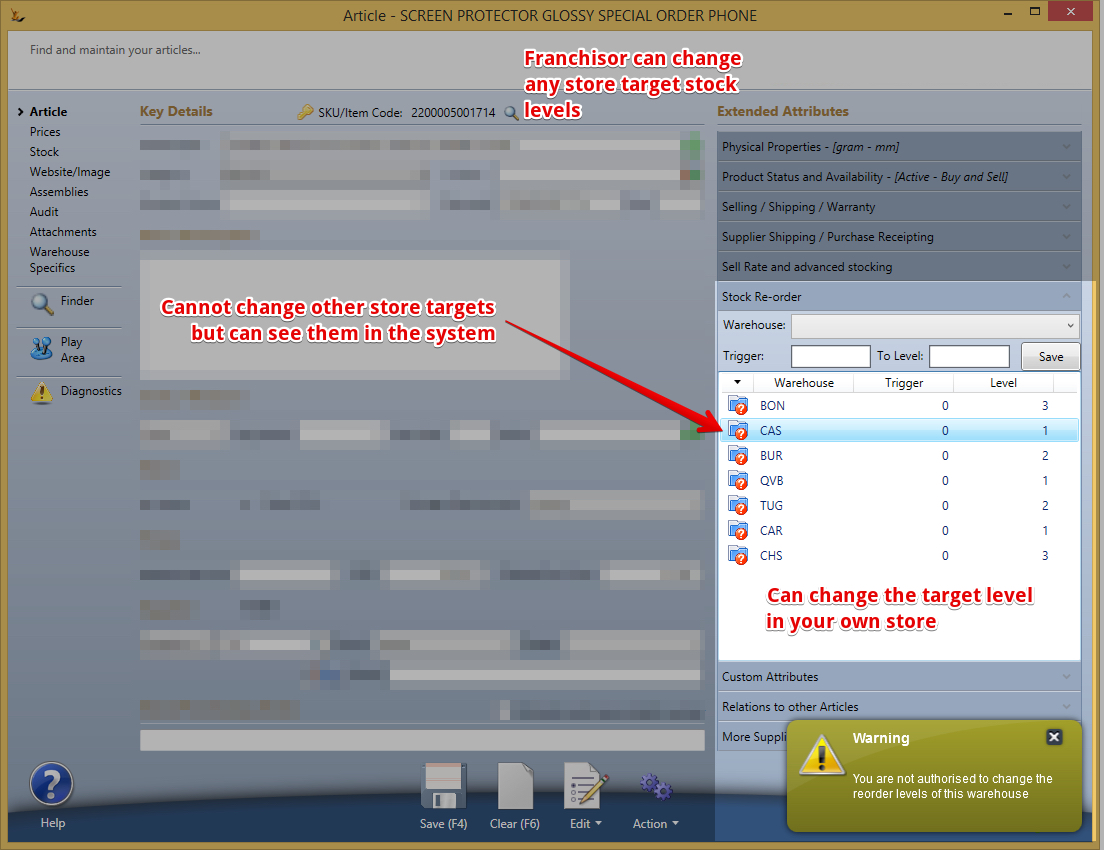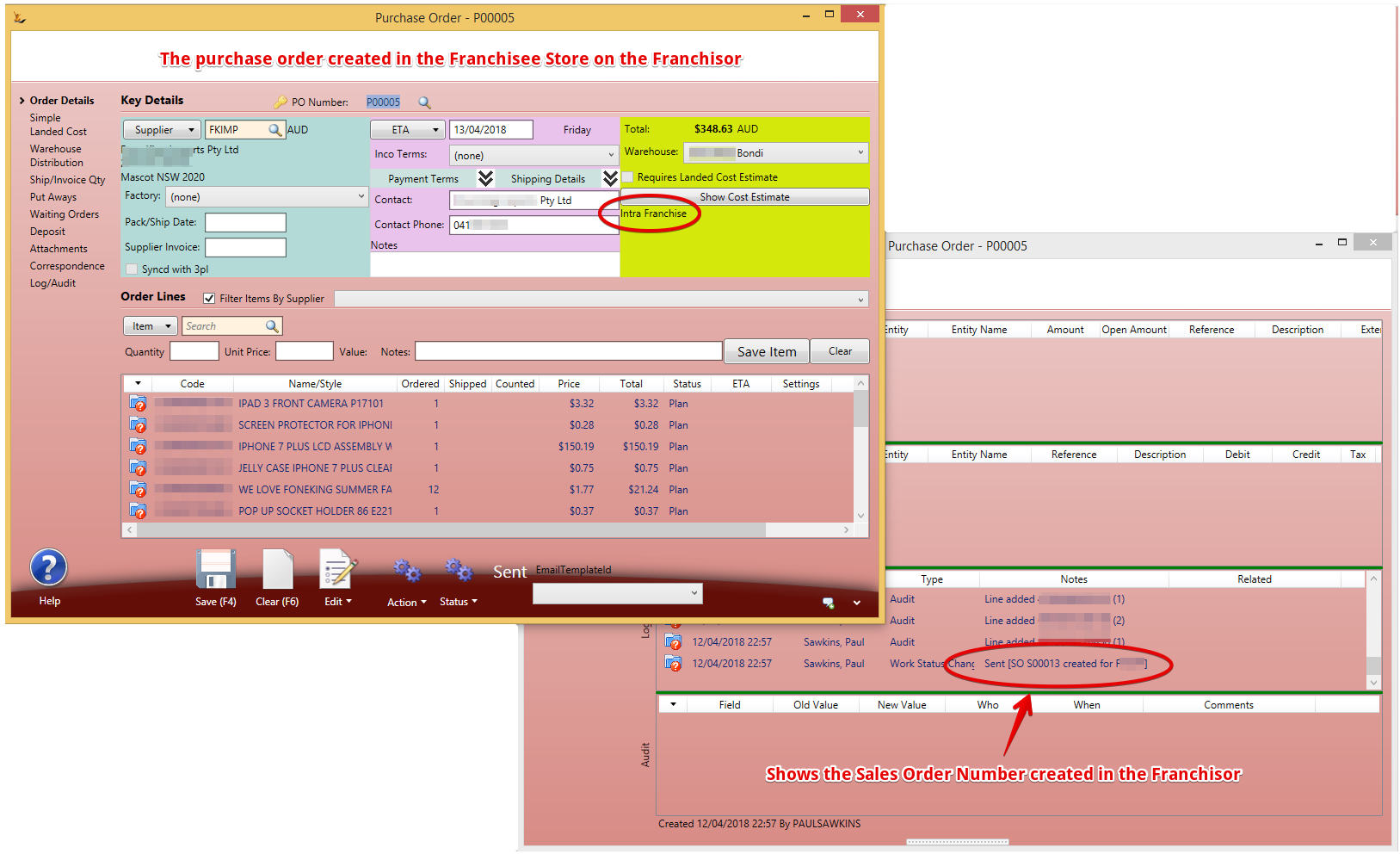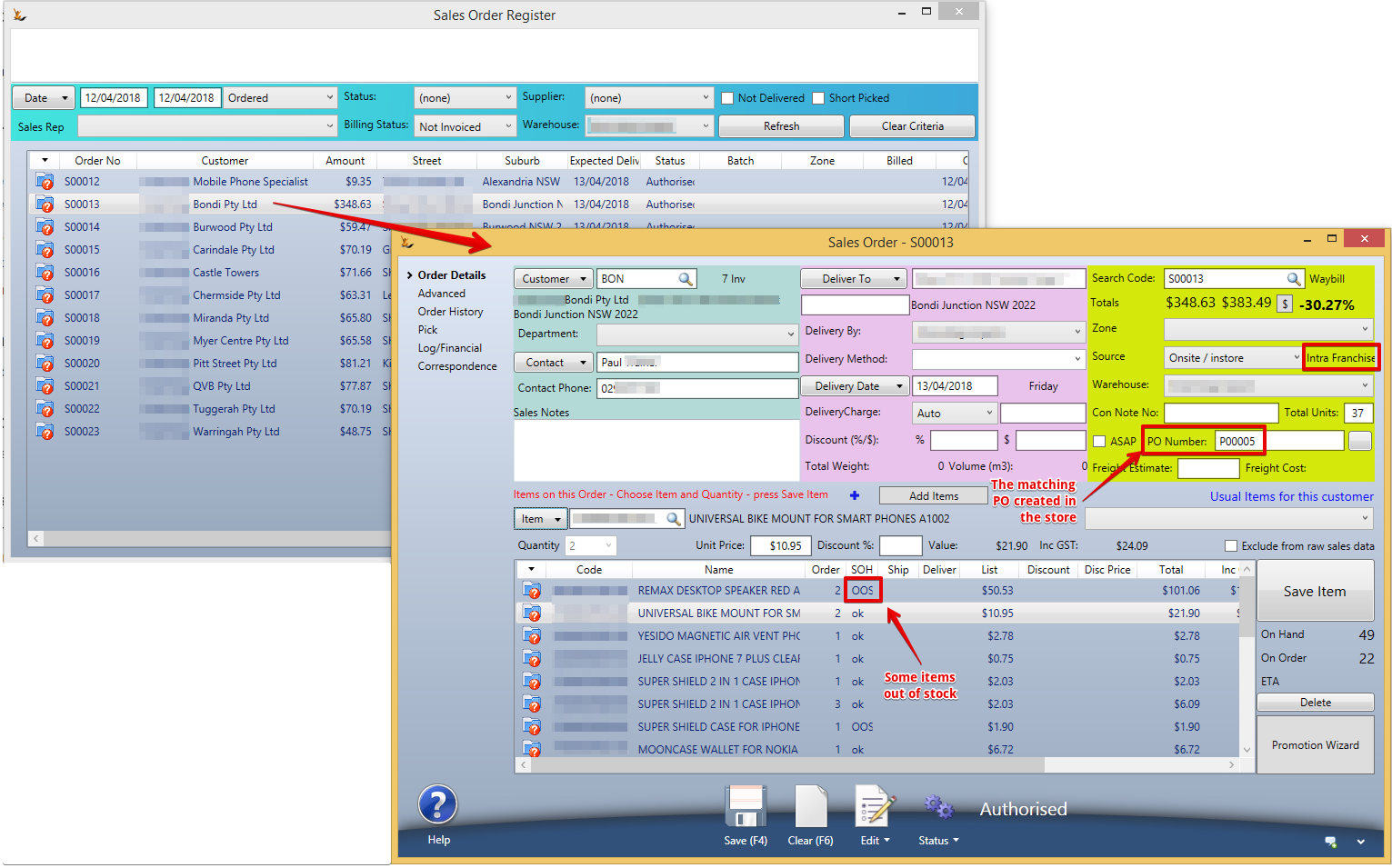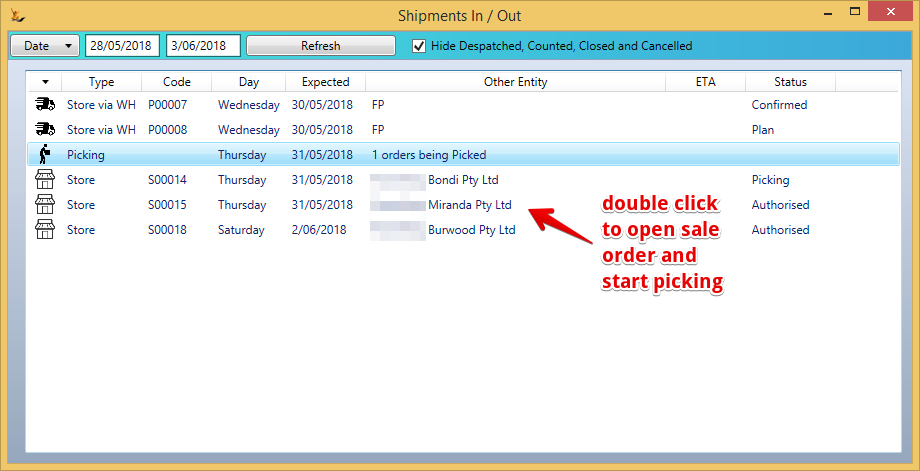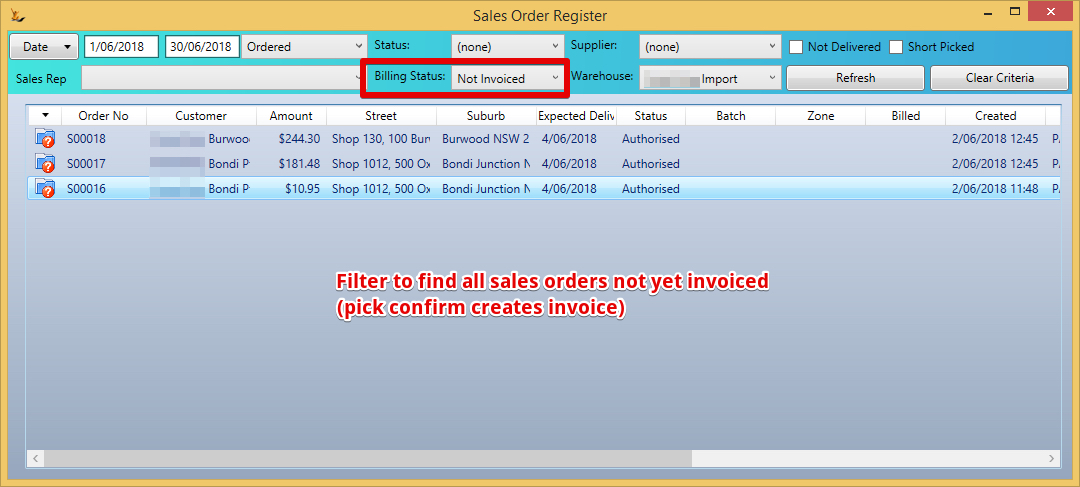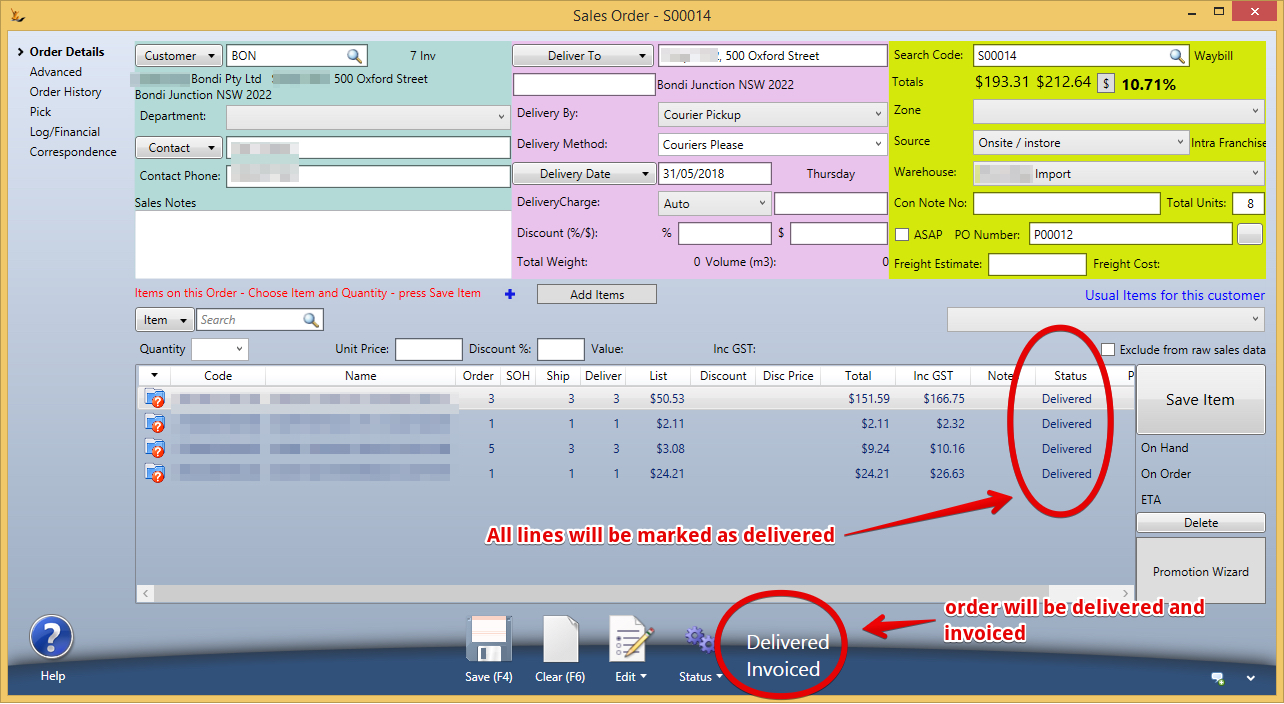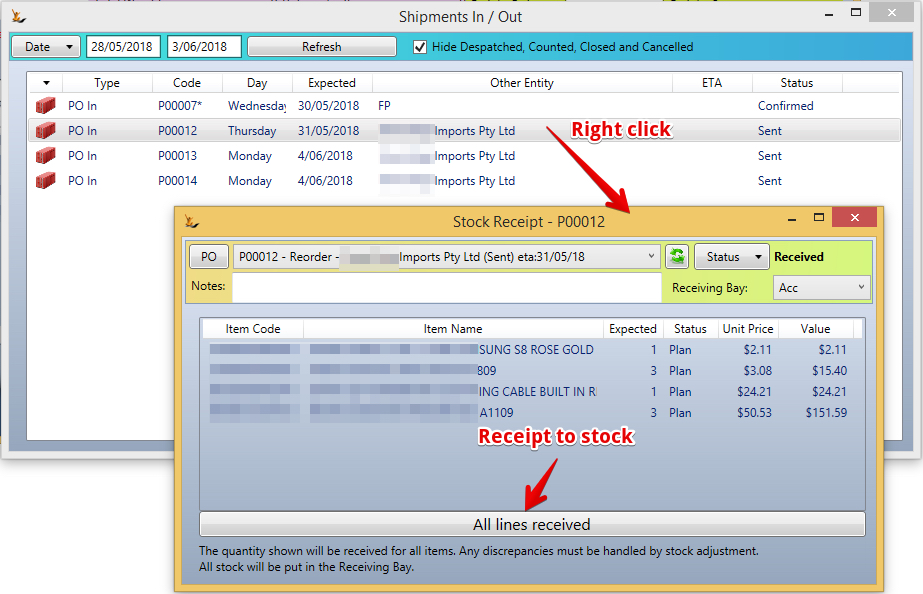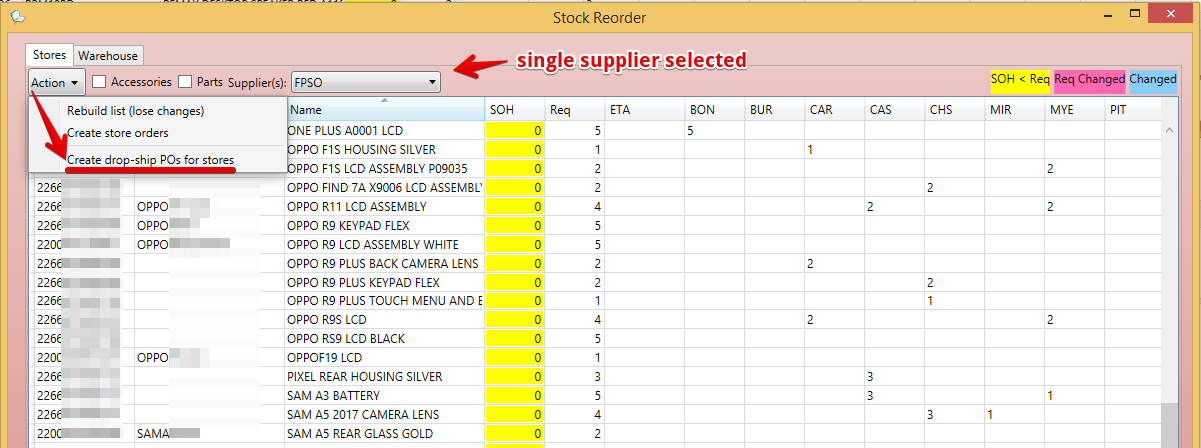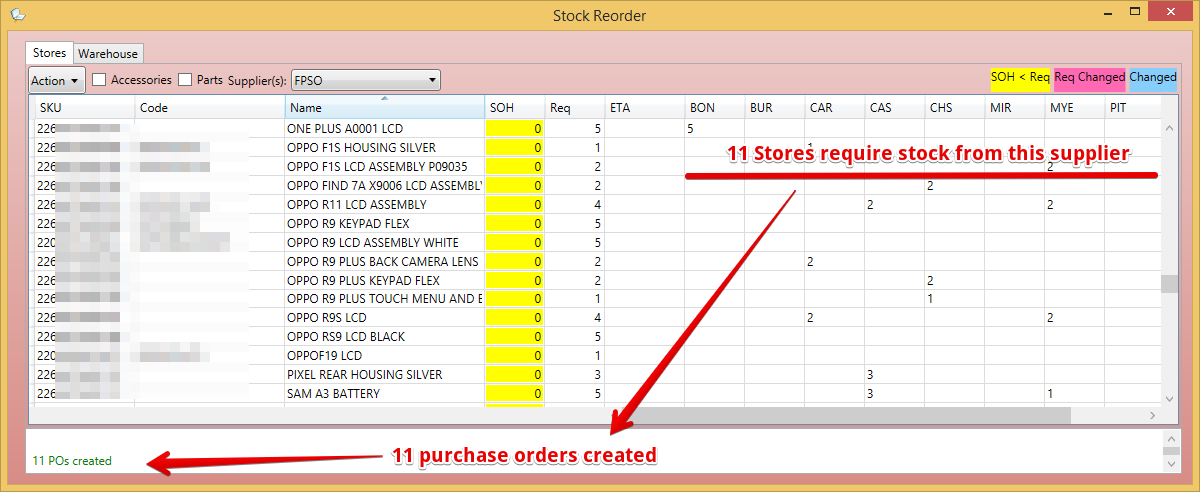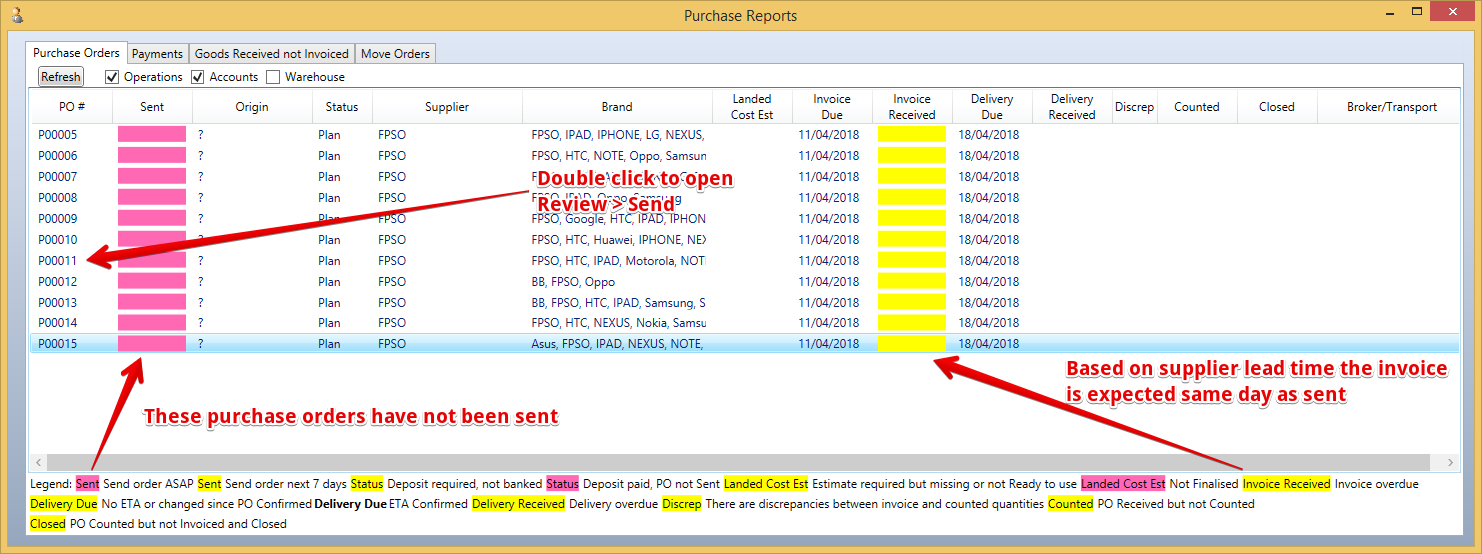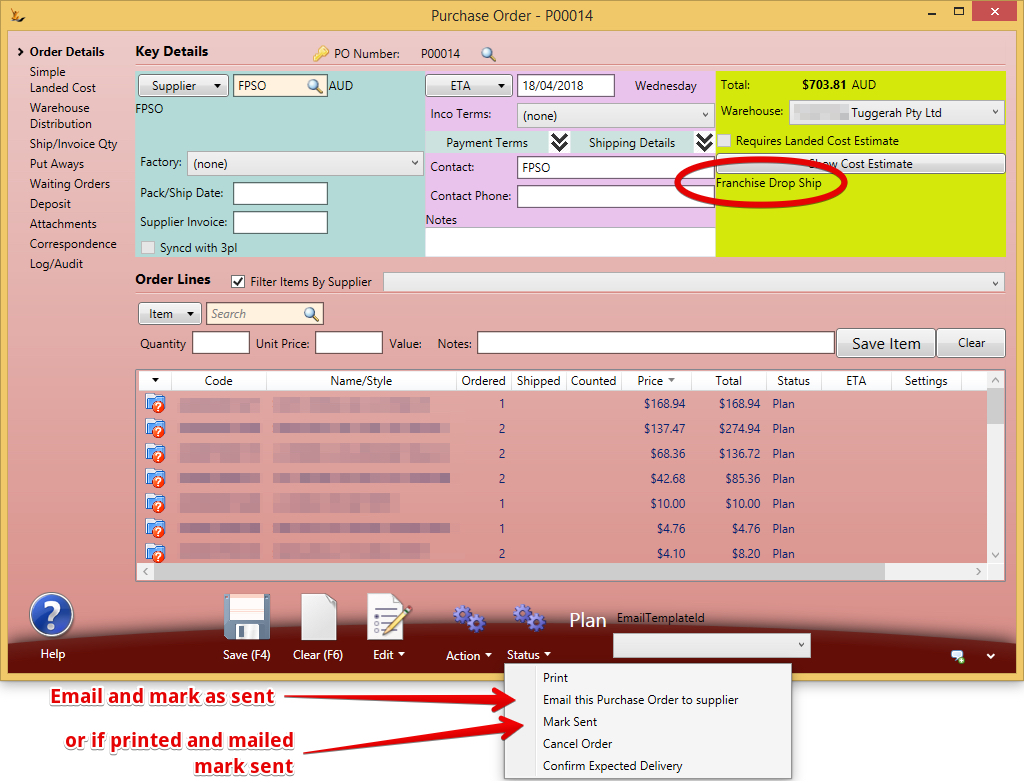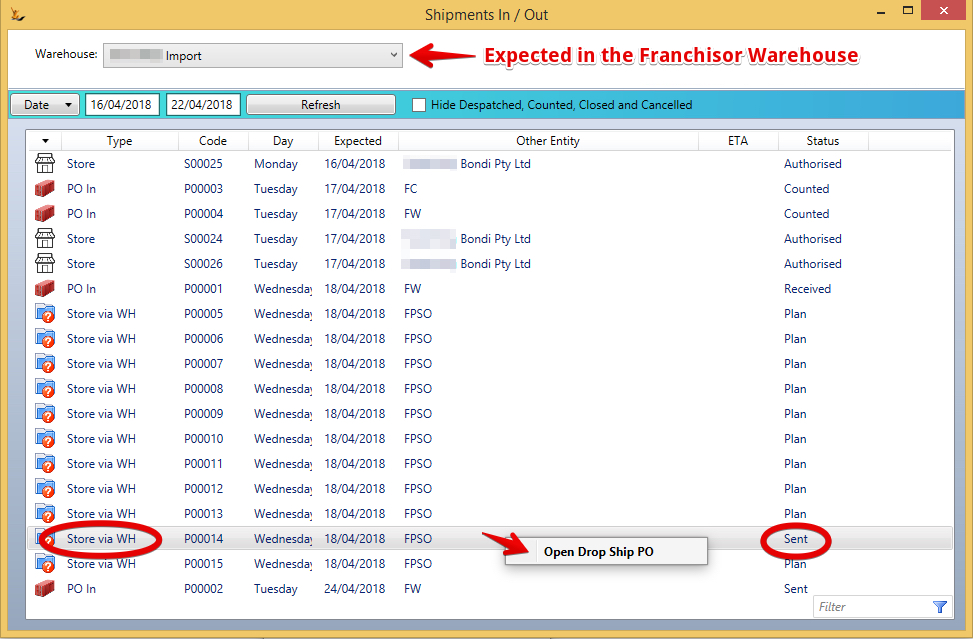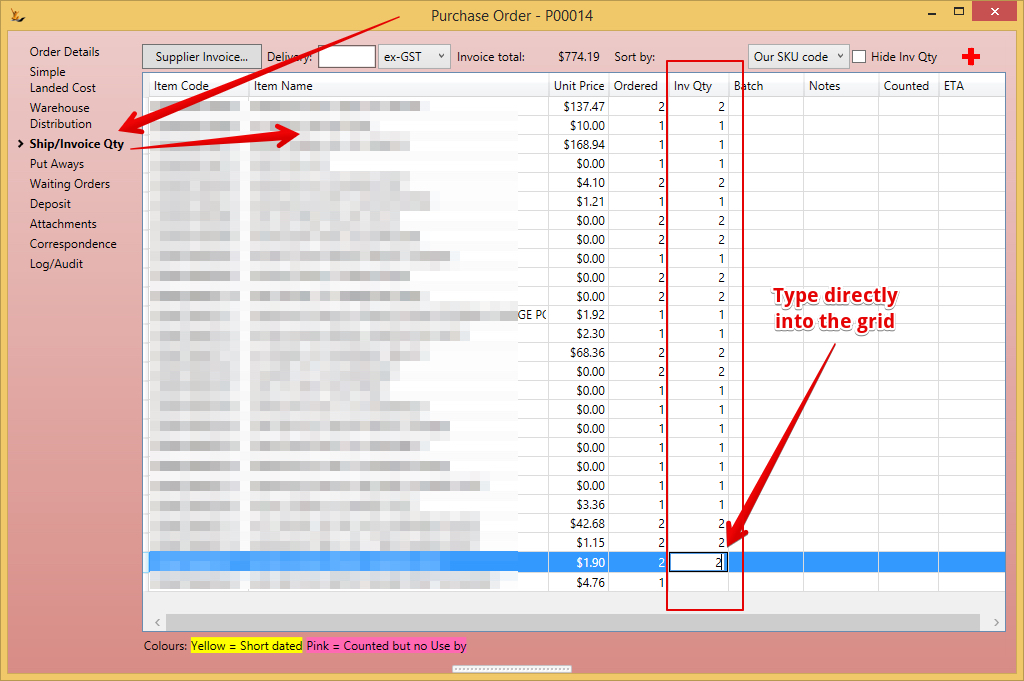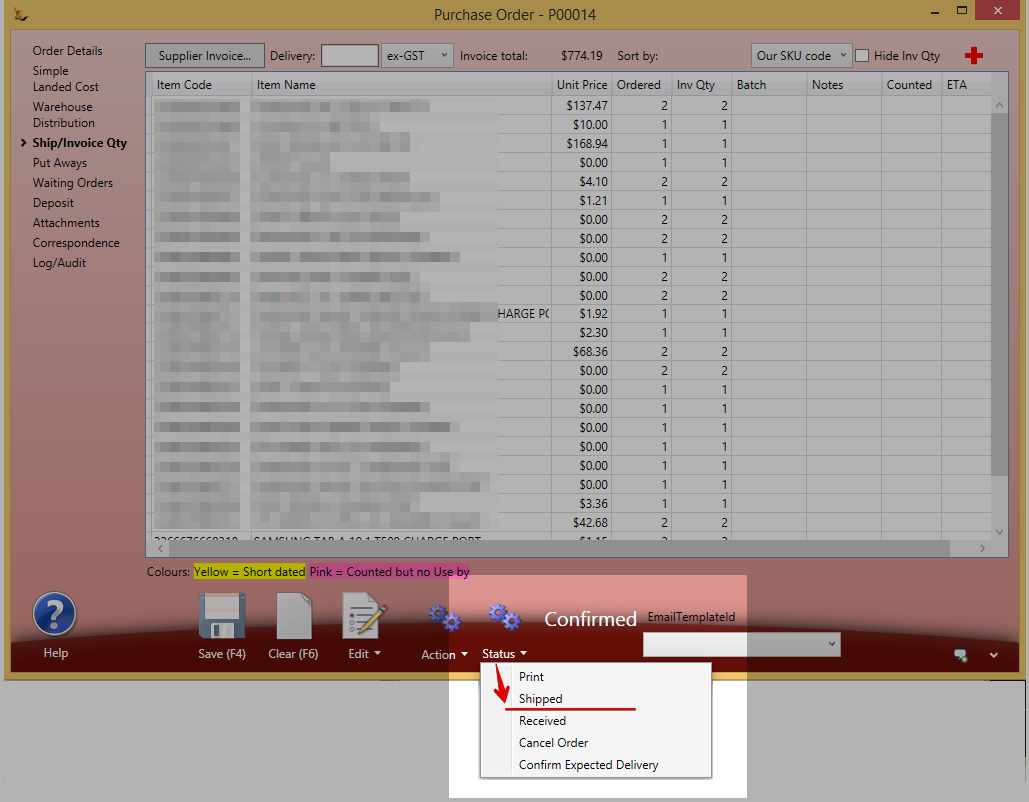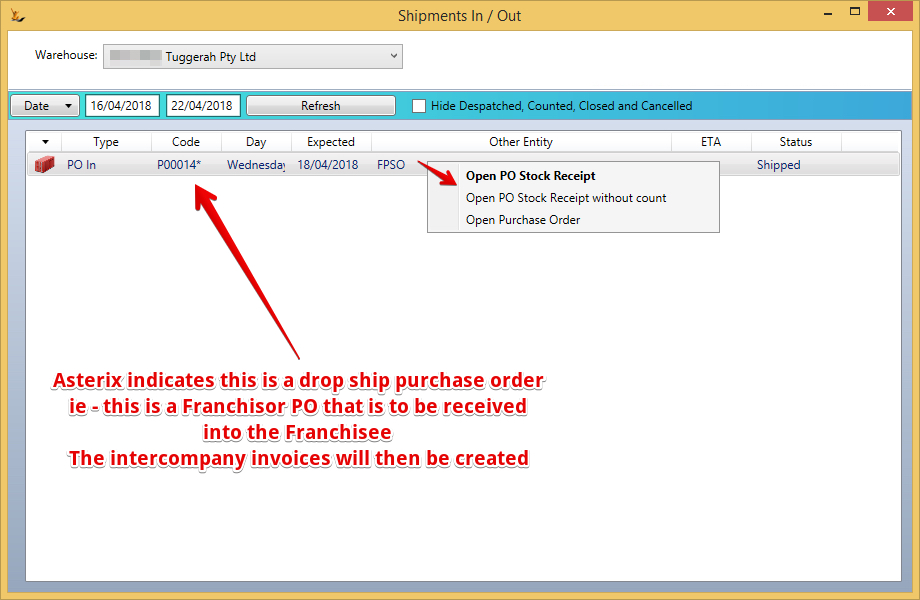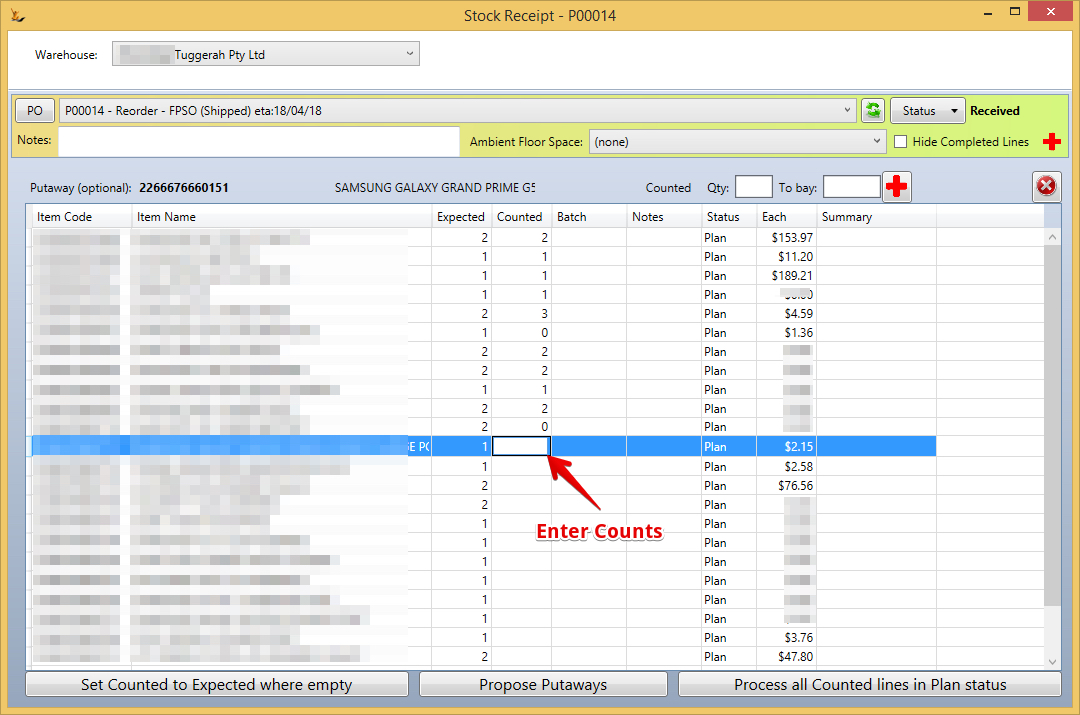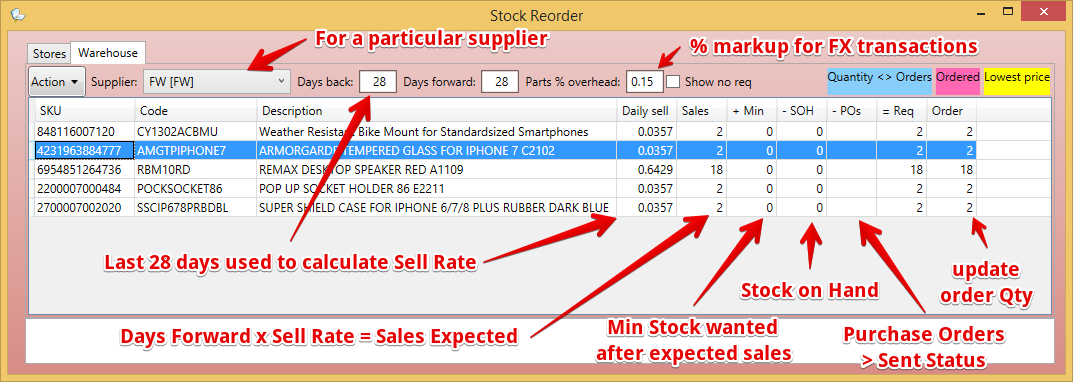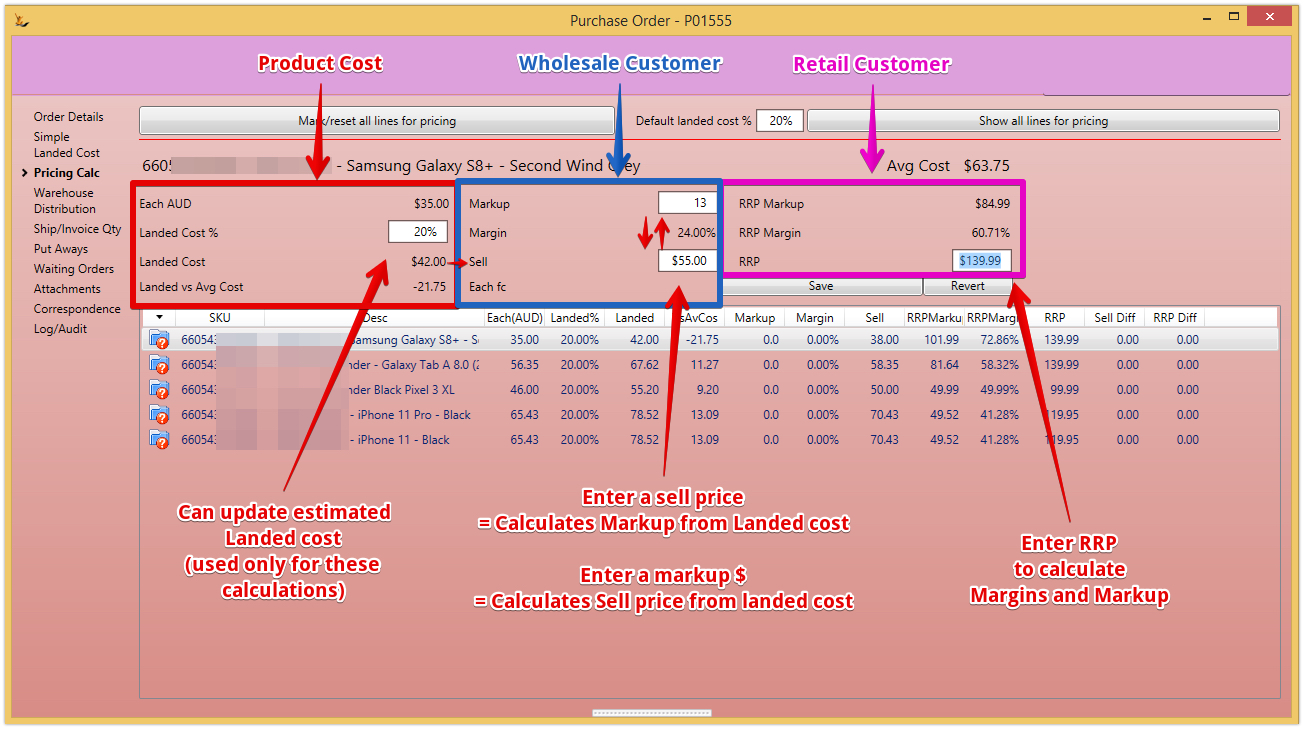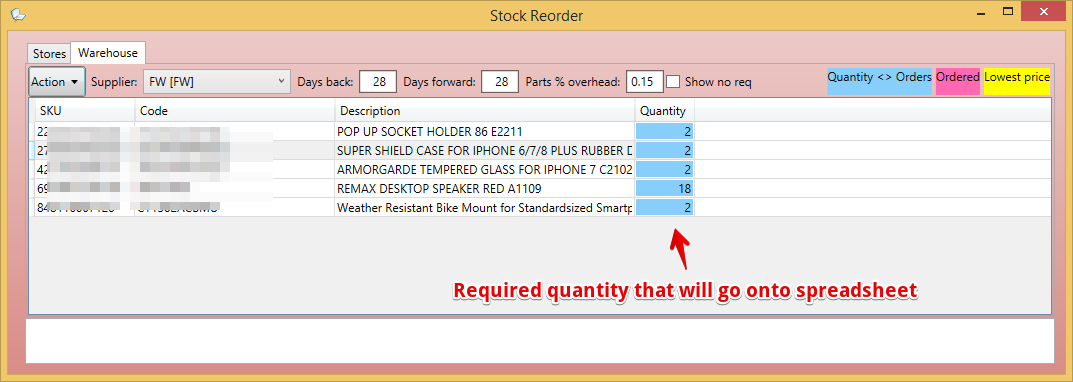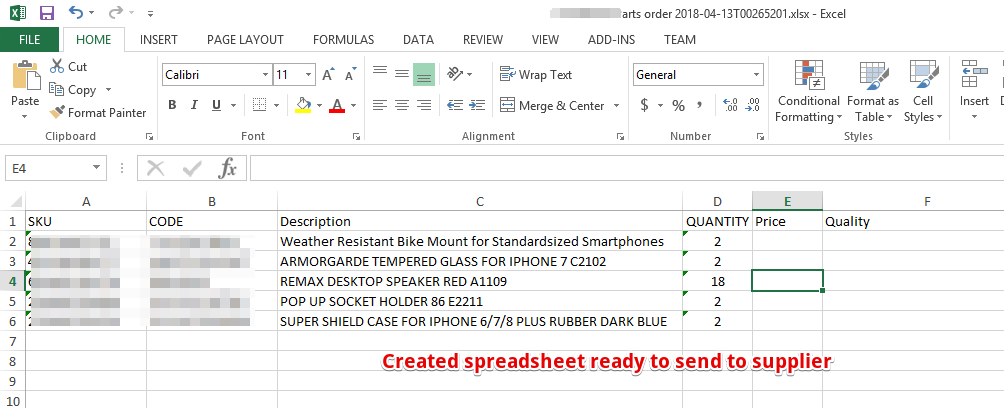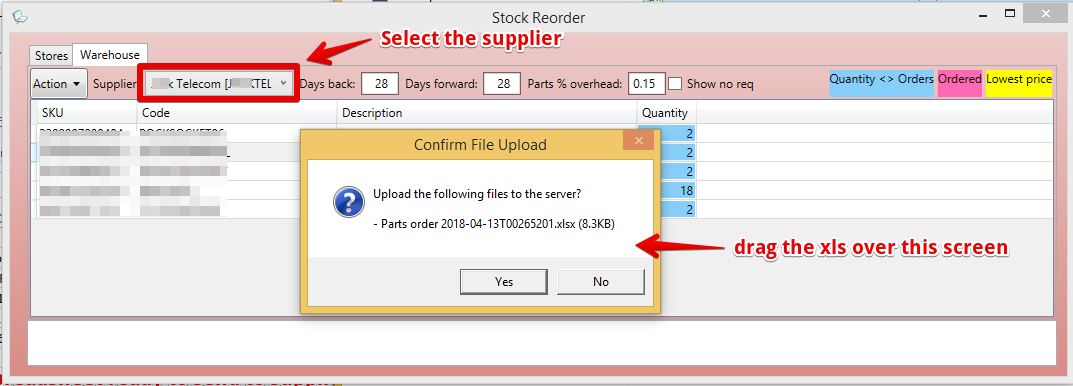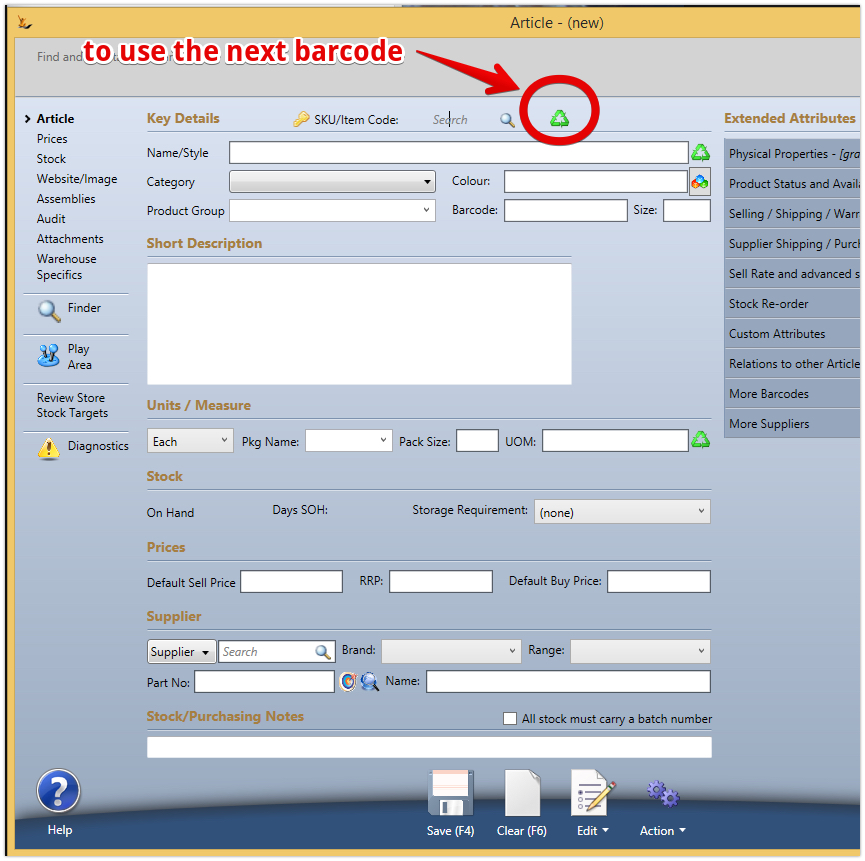See also Store Batches - sending multiple orders in a single batch for when multiple orders are sent in a single shipment
A key point to note
Planning warehouse stock levels uses retail sales data less expected PO's - it ignores sales orders from the retail store to the warehouse
Planning retail stores replenishment uses Store Max target levels - always filling to target
Table of Contents
This training document steps through the way the franchisor warehouse manages purchasing
- for the Franchisor Warehouse
- for the Retail Stores (Franchisees)
Target Stock in Retail Stores
Each store has a target stock level for each item
- Stores do not stock based on sell rate - instead a person decides to carry more or less stock of an item at the store.
Every replenishment from the Franchisor aims to achieve target stock level (after other known requirements)
- Change of the target stock level on any stock article is only available to the Franchisor
Articles which have a Trigger set will be refilled to target when Stock on Hand is less than or equal to the Trigger.
Stock from Franchisor Warehouse to Retail Store (single click all stores)
Franchisor
Review and allocate available stock
Using existing stock (or stock expected soon) plan the shipments going today or tomorrow to the retail stores.
For items that are picked from Stock in the Franchisor Warehouse then sent to the stores - a purchase order is required from the store to the Franchisor and a matching Sales order in the Franchisor.
- Filter the items using multi-select of the suppliers.
- Update the Grids
- single click create the Retail Store Purchase Orders + Franchisor Sales Orders
The concept is to review all the requirements that can be fulfilled across all the retail stores at once
- Compare requirements with stock on hand
- Ignore unpickable locations (pick sequence is -ve)
- Provide visibility of expected stock ETA
- Adjust quantities to manage scarce stock across the stores
 If you make changes in the screen and close the screen the changes are lost. The reason is that the next time you open it the data is likely to be different
If you make changes in the screen and close the screen the changes are lost. The reason is that the next time you open it the data is likely to be different if you do not adjust then sales orders will be > SOH with first picked getting the stock
if you do not adjust then sales orders will be > SOH with first picked getting the stock
- When finished - create all the transactions at once
- Purchase orders in every retail store
- Mirror sales orders in the Franchisor
- Then the sales orders are ready to be picked in the Franchisor
Screen Explained
Select the stores to plan in a single plan
Each Retail Store is a column in the grid
Can edit the data in the grid (hover will show original calculated value once edited)
- The total of all stores is Requirement (Req).
- If manually updated (red) mouse tip will indicate original value
- ETA is date of next PO expected
- hover indicates list of expected PO's, Status, ETA Date and Qty
- Purchase Order lines that were expected more than 6 week ago are ignored
- SOH is qty in warehouse at the moment (ignores stock in unpickable locations ie pick sequence is negative)
- PARTS - are "Buy Only" items used in repairs
- ACCESSORIES - are any saleable product
- Supplier filter - every stock item has a listed supplier - this is used to filter the items shown
Refill calculation:
- Achieve Target qty for each item (set at store level)
- PLUS order lines
- Authorised but not picked
- "Waiting" for stock
- PLUS parts in repairs marked "Waiting" for stock
- LESS current stock on hand
- LESS current purchase orders (for this warehouse) > sent not yet counted by the store
Articles sourced from multiple suppliers > the default supplier is set to a Phantom supplier. See Parts Price comparisons below.
Only shows items if they have a status of Active or Proposed, or a status of Runout and the Warehouse SOH > 0.
Action = "Create Store Orders" > Creates Purchase Orders in each Retail Store AND Sales Orders in the Franchisor
A Purchase Order is created in each of the Franchisee Stores. Note STATUS = Sent
A Purchase order can also be created manually in the Franchisee and it will create a mirror PO
Mirror Sales Orders are created in the Franchisor
Each Purchase Order that is created in a Retail Store has a mirror Sales Order in the Franchisor
Sales Order Register shows the list of the Sales Orders created in the Franchisor
- Note the status is AUTHORISED - ie ready to pick, Line Status is "Plan"
- Note the link to the Franchisee Purchase Order number - PO Status is "Sent", line status is "Plan"
Sales order created in Franchisor to Franchisee will create a mirror PO
Pick the sales order
The warehouse in/out dashboard lists all orders that need to be picked
Or find from Sales Order Finder
Pick each sales order
Sales Order Status will change to "Picking", Line status will be "Plan"
Picking slip - pick and update quantities
Note that the pick sequence is based on the pick sequence setting in the warehouse.
If using Store Batches
If NOT using store batches
Drop Ship Suppliers (Franchise Drop Ship PO)
Drop Ship Suppliers are suppliers that there is no need to stock in the warehouse because they :
- have a short Lead time (eg same day)
- will create a shipment per store
- will ship to the warehouse where the order is checked prior to forwarding on
So replenishment of the store requirements involves creating a Drop Ship Purchase Order for those suppliers
- Stores Dashboard > Select a single supplier
- The Action Option "Create a drop ship PO per store" will be available
Limit suppliers to a single supplier in order to enable this option
Prices will be latest agreed price - maintained on Article as buy price. Note that Buy Prices may have volume price breaks
Stock on hand (SOH) is expected to be zero for all these items
Review the quantities required by the stores - update the grid directly for each store
Franchisor
Manually Create Drop Ship Via Warehouse Individually from the PO screen
Manually create a drop ship via warehouse purchase order:
- Switch to the franchisor.
- Open a Purchase Order form.
- Before saving, from the Status menu select 'Drop Ship via WH to Store:', select the state of the store and then the store.
- The store will be chosen as the Warehouse, the PO type will show as 'Franchise Drop Ship' and the franchisor warehouse address will be set as the delivery address.
- Select the supplier and items and process as normal.
Bulk Create for Franchisees from the Stock ReOrder Dashboard
1 purchase order per retail outlet is created - they are not automatically sent to the supplier as you may want to adjust them after talking with the supplier before sending them.
Review and Send the Drop Ship Purchase Orders
These purchase orders are created in PLAN status - find those that need action on the Purchase Reports Dashboard. Open and email or mark sent
Open the Purchase Order > Email or Mark Sent
The purchase order is now expected at the Franchisor Warehouse
The PO ETA date will cause it to display in the warehouse in/out dashboard. The Type is "Store via WH" (Retail Store via Franchisor Warehouse)
IF using store batches
Store batches enable sending of a group of sales orders and purchase orders all at one time.
See Store Batches - sending multiple orders in a single batch - start a store batch and select the purchase order. Any lines that the supplier has sent can be added to a store batch. Any lines the supplier has not yet sent will be able to be added to a later store batch
If not using store batches
Franchisor purchasing to replenish the Franchisor Warehouse
This dashboard is for stock that moves regularly and does not have expiry dates
This does NOT require the Purchase Orders for each store above to have been created. The stock required in the warehouse IGNORES purchase order/ sales order transactions between the Retail Stores and the Warehouse
- So it does not matter if you create the store orders for the warehouse before or after purchasing for the warehouse
Warehouse Demand uses the sales in each store to calculate overall daily sell rate that the warehouse needs to support
- Existing purchase orders (into warehouse or Drop Ship into retail store) reduce the stock requirement for the warehouse
Planning
This purchasing planner uses the sell rate of each item to determine how many to purchase to cover a number of days of stock. By default it only shows Items that need action.
- Pick a supplier (only a single supplier may be actioned at a time)
- Enter days back and days forward
- Sell rate = total sales days back / number of days
- Sales = sell rate * days forward
- Enter Part % Overhead. Where a supplier charges in FX then an overhead can be applied
- Show no req: can list all items that have a sell rate regardless if they are required
Columns in the Report
- Daily Sell: Calculated Daily Sell rate
- Sales: # of items required to cover sales for the days forward
- Min: Min Stock Level desired after sales
- SOH: Current Stock on Hand
- PO's: Quantity expected on purchase orders in SENT Status or later and not counted
- Req: is requirement after considering all of the above
- Order: Editable column that starts with the Req value
Calculations
- Number of sales in the number of days back / number of days back = average daily sales
- Multiply by number of days forward = target
- LESS stock on hand
- ADD Target Stock level in the warehouse
- LESS purchase orders status SENT but not COUNTED
Changing the Order column - does not save - if you close and open the form the order column will show calculated results only, ie will be the same as Req.
Action > Create a PO with selected supplier
Use this option to create a Purchase Order on the selected supplier
Suppliers will be listed in the Stock Reorder form, Warehouse tab, Supplier filter if:
- There are any Active or Proposed articles that have the supplier selected as the Supplier.
- There are any Active or Proposed articles that have the supplier in the More Suppliers list.
- The supplier has the 'Is Distributor (B2B)' box ticked in the Standard Profile Extended Attributes on the Supplier/Creditor form.
uses order qty - will not be in sent status (so will need to be sent) and will open on the screen
See Purchase Order from PO to Goods Receipt for more details
Retail Markup Adjustments on Purchase Orders
PARTS ORDERS: Action > Save a version for a Parts Order
Parts typically can be sourced from multiple places with some OEM and some aftermarket or other quality levels - hence the need to review multiple quotes
A part is "Buy Only" Stock Article and generic (can be sourced from multiple suppliers)
Use this option when the products can be sourced from multiple suppliers
There can only be one parts order at any time
saves qty to the database for all items in the list - so can come back and work on the overall order later
The version can then be exported as a spreadsheet that is
- Sent to multiple suppliers to quote on
- Received back with quoted prices and quality comments - and uploaded
Action > Create parts quote spreadsheet
- Action menu:
- Option 'Create Parts quote spreadsheet' only available if Parts order list displayed.
- Option 'Import Parts quote response from ...' only available if Parts order list displayed.
- Option 'Create and Email Parts Purchase Orders to Suppliers'.
- Uses Email Template with System Usage of Created, Usage Context of Purchase and Recipient Role of Supplier, if found.
- Email BCCed to user.
- Email logged in Correspondence of supplier, purchase order and user.
send to supplier for them to quote on the XLS generated
Supplier Quality column should be one of:
- ORGNW - Original new
- OEMA - OEM grade A
- ORGRF - Original refurbished
- ORGFOG - Original FOG
- NG - Aftermarket / non genuine
- HCPY - High copy
When received back from supplier with prices / quality comments
Drag the XLS over the screen later when received - select the correct supplier it came from - ACTION> import parts quote response
Find by barcode will be used if sku not found (ie if SKU's have been merged since the spreadsheet was sent to the supplier)
Review and compare suppliers
Action > Review parts order
Supplier prices are in the currency of the supplier (essentially the raw data provided from the supplier) - so if suppliers have different currencies the price comparison may be misleading
Once an order quantity is entered for a supplier - the AUD value is calculated by converting the price from the suppliers currency and adding the Parts % overhead. Example - from below - the "weather resisitant bike mount we accepted Jacktel price of $100 USD x (1 / 0.7 ) AUD per USD x 1.15 parts % overhead = $164.29. Note also the AUD value is not an average - it is from the last column ordered - see first line below as an example
Steps
- Manually edit by enter quantities by supplier on any item - for example when a supplier has informed you they cannot supply the entire quantity
- either
- Order best value where no order
- or create purchase orders only for those manually updated
System rules - creates Priority for cheapest price of similar quality. Only top 3 quality levels will auto-order
Action menu, 'Order best value where no order' will order from supplier with:
- Lowest price of ORGNW or OEMA, if any, or
- Lowest price of ORGRF, if any, or
- Lowest price of ORGFOG
- If none of the above then no order will be set and the Quantity column will be highlighted blue
Create parts purchase orders
- Created Purchase Orders are direct to sent status + Creates spreadsheets to send to supplier of the accepted order.
- Action menu:
- Option 'Create and Email Parts Purchase Orders to Suppliers'.
- Uses Email Template with System Usage of Created, Usage Context of Purchase and Recipient Role of Supplier, if found.
- Email BCCed to user.
- Email logged in Correspondence of supplier, purchase order and user.
- Option 'Create and Email Parts Purchase Orders to Suppliers'.
Purchase orders will be received in the warehouse - see Also Purchase Order from PO to Goods Receipt, Purchase Reports Dashboard, Purchase Order Variations and the general help areas Purchasing Stock and Warehouse role training plans
Two types of suppliers explained - Drop Ship / Normal
There are broadly two types of suppliers - and this affects how the stores are replenished the stock items
- Drop Ship = Short Lead time suppliers that will create a shipment per store
- Normal = Longer lead time suppliers (stock needs to be held at a central warehouse
More detail
- "Drop Ship Suppliers" = No stock needs to be held in the Franchisor Warehouse for Suppliers with short lead times that will package per store
- A Drop Ship Purchase order is sent to the supplier per store (Address = Franchisor Warehouse)
- Franchisor checks counts the delivery at the warehouse, then sends it onto the Retail Store - where it is check counted again
- Normal Suppliers = Stock needs to be held in the Franchisor Warehouse
- Retail Store purchase order to the Franchisor
- A mirror sales order in the Franchisor to be picked sent from the Franchisor Warehouse
A diagram showing the different flows required by the two types of suppliers:
Internal Barcode Generation Process
When defining a SKU that requires a barcode there are two methods
- Use the barcode button on the SKU form (if the SKU does not already have a barcode)
- Import via XLS a range of SKU's with a column called "Barcode" with the value
[AUTO]
Clicking the button will
- reserve the next available barcode and put it in the SKU and Barcode fields.
- Can only be done for a new article with no SKU or Barcode
- If article is not saved then the barcode will be 'lost' and will no longer be available for auto allocation - ie once populated in the form save it or can only use it manually
- Any barcode already in an article SKU, Barcode or 'More Barcodes' list will be skipped.
Setting up the barcode prefix and length
- Two Company/Context Specific Symbols Configs need to be set up in the franchisor, if any:
- Key: AutoBarcodePrefix - will contain the initial characters of the barcode.
- Key: AutoBarcodeLength - the number of characters in the barcode.
- The barcode after the prefix will consist of a numeric sequence, with leading 0s to make up the length, incremented by 1 each time a new barcode is generated.
- Auto barcode generation will fail if the sequence is fully allocated, e.g. prefix of 710000 and barcode length 13 would have a sequence of 7 digits so barcode generation will fail after the sequence reaches 9,999,999.
- If the sequence length is 9 or more digits auto barcode generation will fail after the sequence number reaches 999,999,999.
- If you change the prefix and want the sequence to start with anything other than 1 (with leading 0s) then speak to Saasplications support and they can set this up. A prefix of 7100 and a length of 13 digits would normally start with 7100000000001.
